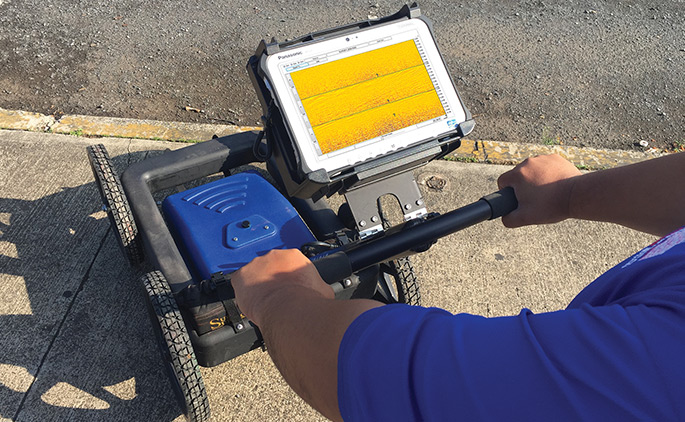December 2015 Vol. 70 No. 12
Features
Hawaii Geophysical Solves Underground Problems

Even paradise needs air conditioning. To prove the point, Honolulu Seawater Air Conditioning LLC, is in the early stages of a 25-year contract that will use innovative, energy-saving technology to provide air conditioning to a large section of downtown Honolulu, HI. To address the challenges, Honolulu Seawater Air Conditioning turned to Hawaii Geophysical Services, specialists in underground utility locating.
The privately funded, $250 million project which is now underway will be the largest scale implementation in the United States of seawater air conditioning, a self-descriptive technology that pumps 45 degree F seawater from more than 1,700 feet below sea level through heat exchangers, chilling freshwater in a closed-loop pipeline system used for air conditioning buildings.
While the technology has been proven around the world, the devil is in the details and in the case of the Honolulu project, those details include dealing with underground utilities, unexpected obstructions and other subsurface anomalies – including unusual geology – that could add time and cost to the job.
Using GPR to Locate Underground Utilities

“We found utility lines of all sorts, where the existing plans and drawings showed none,” said Paul Vierling,
general manager of Hawaii Geophysical Services. “We found conflicts at depths that were not the depths indicated on existing plans and drawings. We found obstructions that were unknown that would have resulted in significant cost increases. We discovered boulders, old slabs and roadways.”
Hawaii Geophysical Services primarily relied on ground-penetrating radar (GPR) units from US Radar to locate underground obstructions and infrastructure systems. GPR has been a primary tool within Hawaii Geophysical Services’ toolbox for more than 10 years, and is now used on approximately two-thirds of the company’s projects.
In addition to using GPR technology on the project, Vierling said the company also excavated 22 “keyholes” that facilitated video recording and photography of underground conditions. “It’s the only way to 100-percent verify what’s under the ground,” Vierling explained.
Honolulu Seawater Air Conditioning employed an archeologist on site, who took samples from each of the keyhole excavations.

“One day, we were going along and found bones and a beer bottle,” Vierling recalled. “The archeologist was ready to stop the job on seeing the bones, but our technician spotted the bottle and realized it was someone’s lunch.”
Ground penetrating radar provides an image of the soil structure. Differences in the soil structure show up as anomalies. “We’re not so much finding the objects as seeing the disturbed soil,” Vierling said. “It takes a combination of technical acumen and real-world experience to be able to say to a customer with authority, ‘That’s an electric line,’ or ‘That’s a gas line.’ ”
Vierling explained that a variety of factors can affect readings – high iron levels or a signal from a nearby transformer, for instance. “In Hawaii, we’ve got iron in the soil. We’ve got lava tubes and volcanic rock. We face unique challenges for utility locating here.”
Hawaii Geophysical Services overcame those challenges in meeting the sub-surface locating needs of the Honolulu Seawater Air Conditioning project.
Saving resources, cutting costs
When completed in 2016, the seawater air conditioning district cooling system in downtown Honolulu will efficiently produce chilled water at a central plant with a capacity of 25,000 tons per day – enough to air-condition an area of 12.5 million square feet. This will then be piped to air conditioning systems in individual buildings, resulting in the elimination of chillers and other expensive equipment.
Through 2014, six large downtown buildings – including the Kalanianaole Federal Building and U.S. Courthouse – had signed long-term agreements to participate in the project.
Hawaii is currently the nation’s largest per capita consumer of electricity, with air conditioning costs representing the most substantial percentage of the average electricity bill. On Oahu alone, cooling commercial buildings accounts for 20 percent of annual electricity consumption.
By using a natural resource – cold seawater – Honolulu Seawater Air Conditioning’s downtown cooling system will have numerous positive impacts for the community. Not only will it reduce Hawaii’s need for traditional air conditioning methods, it will decrease the state’s environmental footprint and ultimately, its oil dependency by saving 178,000 barrels of oil per year. Among the system’s benefits are the following:
- Saving more than 77 million kWh per year;
- Minimizing greenhouse gas emissions by avoiding approximately 84,000 tons of carbon dioxide per year (the equivalent of emissions from 15,000 cars);
- Decreasing potable water usage by more than 260 million gallons per year; and
- Reducing sewage discharge by up to 84 million gallons per year.
Once constructed, the only visible part of the system will be the cooling station located in Kakaako. The seawater pipes will be placed in micro-tunnels, deep under the shoreline with no added chemicals or other substances. When the water returns, it will be slightly warmer than its original temperature. It will then be released back into the ocean in an environmentally safe manner through a diffuser that mixes with ambient water meeting state water quality standards. When installed, the concrete anchor collars on the submerged pipe will provide a habitat for coral and fish.
Minimizing costs, avoiding dangers
In designing the seawater air conditioning system, project engineers knew the cost implications of not doing thorough locating before excavating. Hawaii Geophysical Services worked with project planners to execute to SUE (sub-surface utility engineering) standards to ensure design accuracy.
“The SUE process is the only way to confirm exactly what you’ve seen underground,” said Vierling, who also noted that his firm routinely helps engineers during the design and planning phase of construction projects. “The best time to locate utilities is during the design engineering phase of a project.”
He added, “Engineers, planners, contractors and builders hire us to avoid danger and cost, with electrical and gas hits being the most dangerous and fiber optic hits being one of the most expensive.” The cost of a strike typically starts at $100,000 and can quickly go to $1 million or more.
“When what you do has the potential to prevent disaster, you want to work with the best,” Vierling said. “When it comes to ground-penetrating radar, we believe US Radar is the best.”
Vierling recently added to their toolbox the newest ground-penetrating radar technology from US Radar, the Quantum Imager, the world’s first triple-frequency GPR device. “It’s incredibly efficient because it combines three antennas in one box, so you can search different depths without switching antenna boxes,” he said.
FOR MORE INFORMATION:
U.S. Radar
(732) 566-2035, www.USRadar.com




Comments